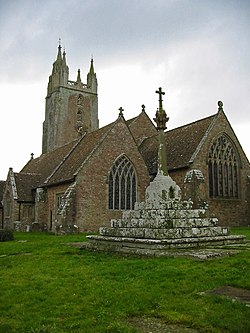Newland, Gloucestershire
| Newland | |
| Gloucestershire | |
|---|---|
 All Saints Church, Newland | |
| Location | |
| Grid reference: | SO554093 |
| Location: | 51°46’53"N, 2°38’45"W |
| Data | |
| Population: | 1,033 (2011) |
| Post town: | Monmouth |
| Postcode: | NP25 |
| Local Government | |
| Council: | Forest of Dean |
| Parliamentary constituency: |
Forest of Dean |
Newland is a village in the Forest of Dean in Gloucestershire, on the east side of the River Wye, three miles south-east of Monmouth. It is notable for its parish church, All Saints, known as the 'Cathedral of the Forest'. It was the centre of a large parish with complex boundaries and scattered settlements.
The church
The church, dedicated to All Saints, was founded shortly before 1216. It was sited on a low, flat-topped hill, sheltered by higher hills except to the south where the land descends to the River Wye. The church comprises a chancel with side chapels, an aisled nave with south chapel and south porch, and a west tower.[1] The tower was begun in the late 13th century, although the upper stages are of the late 14th or early 15th century. The chancel, the chapel south of it, the arcades and aisles, and the south porch are mainly 14th century features, and the north and east chapels were added in the 15th century. The church was thoroughly restored between 1861 and 1863 by William White, who reconstructed much of the chancel, the arcades, and the north aisle wall. Buttresses were added, new roofs were put on, and the clerestory was heightened.[1]
The church contains several effigies including that of Sir John and Lady Joyce of Clearwell who died in 1344 and 1362 respectively, and an effigy of Jenkin Wyrall, Forester of Fee (died 1457), which shows details of the hunting costume of that period.[2] It also contains the "Miners Brass", just one foot high, which depicts a helmet, crest and figure of a mediæval miner of the Forest of Dean with a hod and pick in his hand and candlestick in his mouth.[2] The church is often referred to as the 'Cathedral of the Forest'.[3]
The village
The church had attracted buildings around it by the mid 14th century. The church became the most significant point of reference in the large, dispersed parish: in the late Middle Ages and until the 17th century the village was known as Churchend.[1]
In the 15th and 16th centuries an unofficial market was held at Newland village, the traders taking advantage of the large numbers congregating at the parish church on Sundays and feast days. It probably lapsed during the 17th century when Coleford became a market town. William Jones of Monmouth endowed almshouses in this his home village of Newland.[4] With the growth of Coleford, Newland remained small and mainly residential with two sets of almshouses, a grammar school, and in the mid-18th century a successful private school.[1]
The parish
Newland parish was created in the early Middle Ages by assarting woodland and waste from the Forest of Dean, and its formation was well under way by the start of the 13th century, when the parish church was built. The main block of the parish was formed by the tithings of Newland, Clearwell, and Coleford, but by the 14th century other scattered parcels of land in the Forest were being indiscriminately added to the parish as they became assarted from the Forest waste, which meant that the parish gained 22 detached parts.[1] The largest detached portion of the parish included Bream village. Coleford tithing became a separate civil parish in 1894, and the detached parts were added to other parishes between 1883 and 1935.[1]
The Newland Oak
A short distance north of the village (SO551099) stood the Newland Oak, which it is claimed had the largest circumference of any Common Oak (Quercus robur) ever recorded.[5] Measurements taken by the Royal Scottish Arboricultural Society in 1898 record that the tree had a girth of 46 ft 4ins at 1 ft. By 1950 the tree had lost several large limbs, and the tree suffered a near fatal collapse during a snowstorm in May 1955. The remnants of the tree were set on fire by vandals in 1970. Cuttings were taken in December 1964, and a new tree raised from one of these cuttings now stands where the old oak stood.[5]
Outside links
| ("Wikimedia Commons" has material about Newland, Gloucestershire) |
- Newland Village
- All Saints Church, 'The Cathedral of the Forest'
- Archaeological work at Newland House
References
- ↑ 1.0 1.1 1.2 1.3 1.4 1.5 A History of the County of Gloucester - Volume 5 pp 195-231: Bledisloe Hundred, St Briavels Hundred (Victoria County History)
- ↑ 2.0 2.1 Newland, ForestWeb (fweb), Accessed: 17 April 2013
- ↑ All Saints Church, Newland, Gloucestershire. Accessed: 17 April 2013
- ↑ Heritage Explorer: William Jones' Almshouses
- ↑ 5.0 5.1 Historical Information on Big Trees